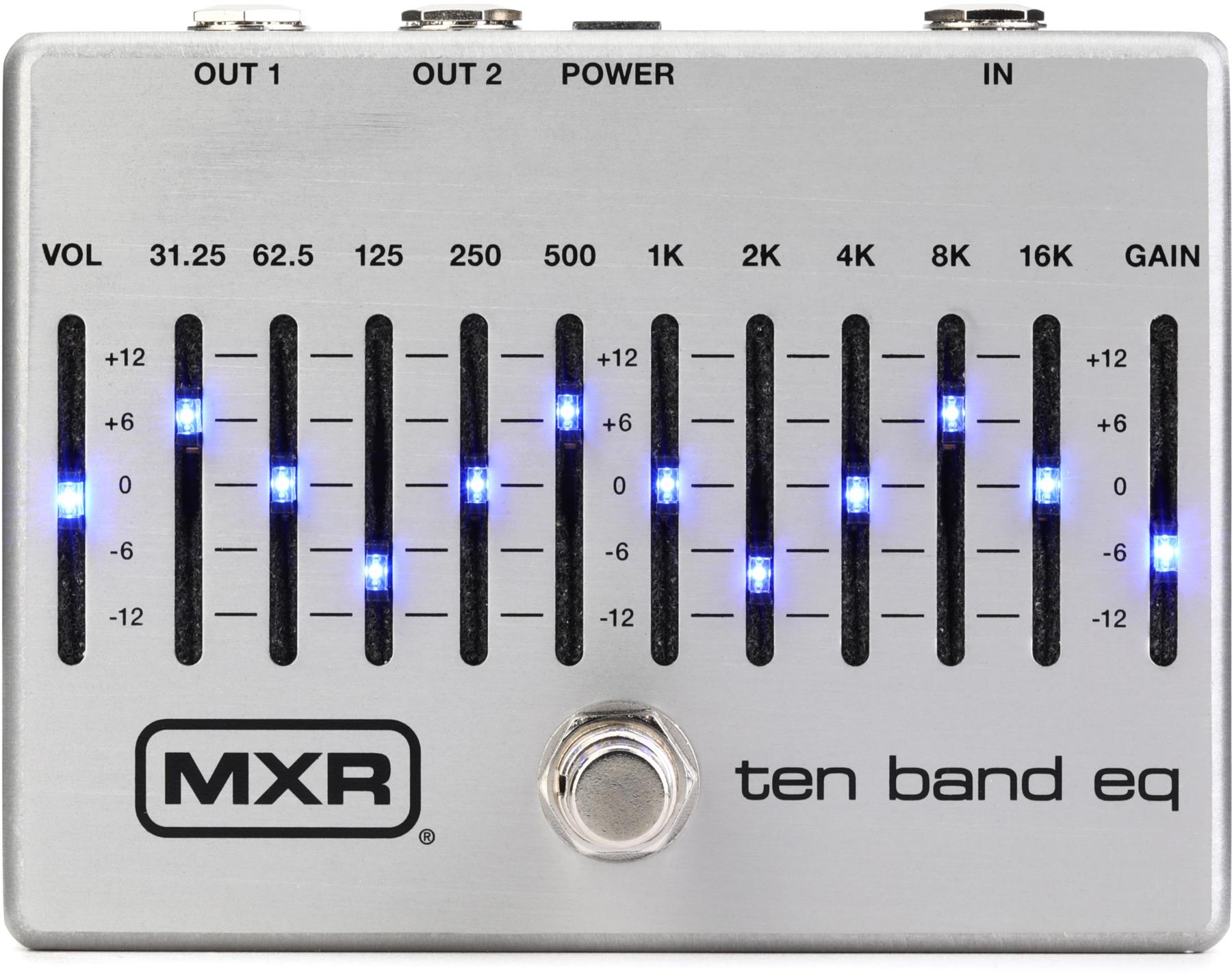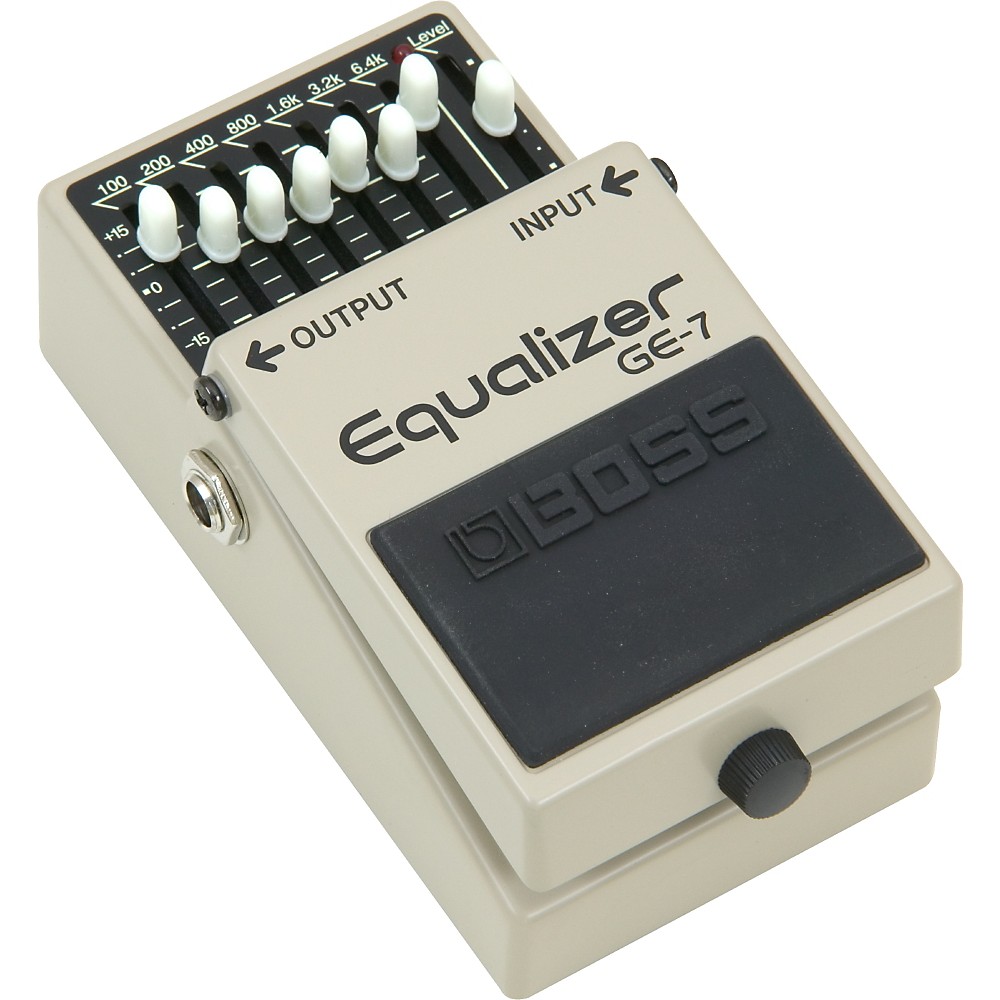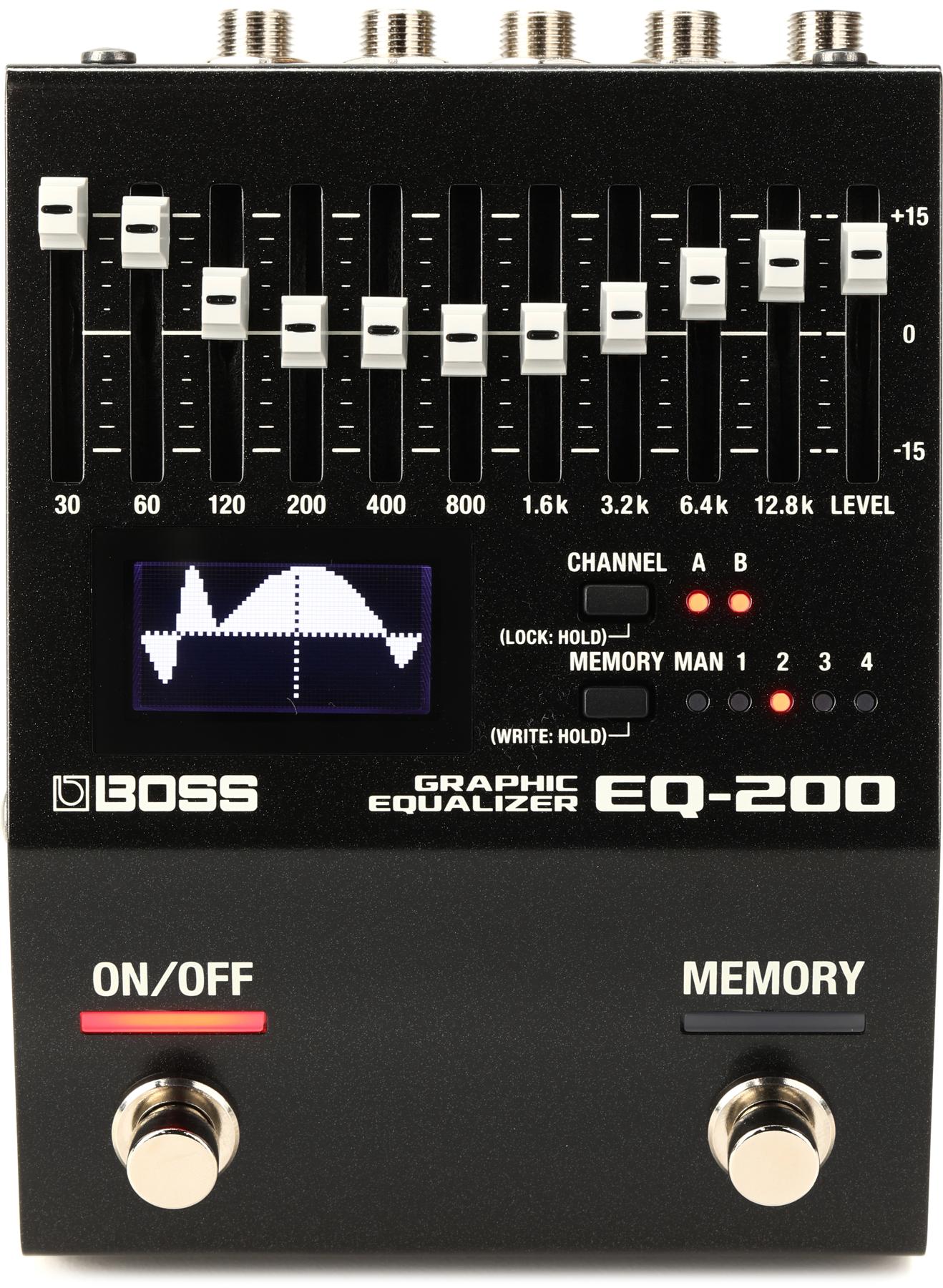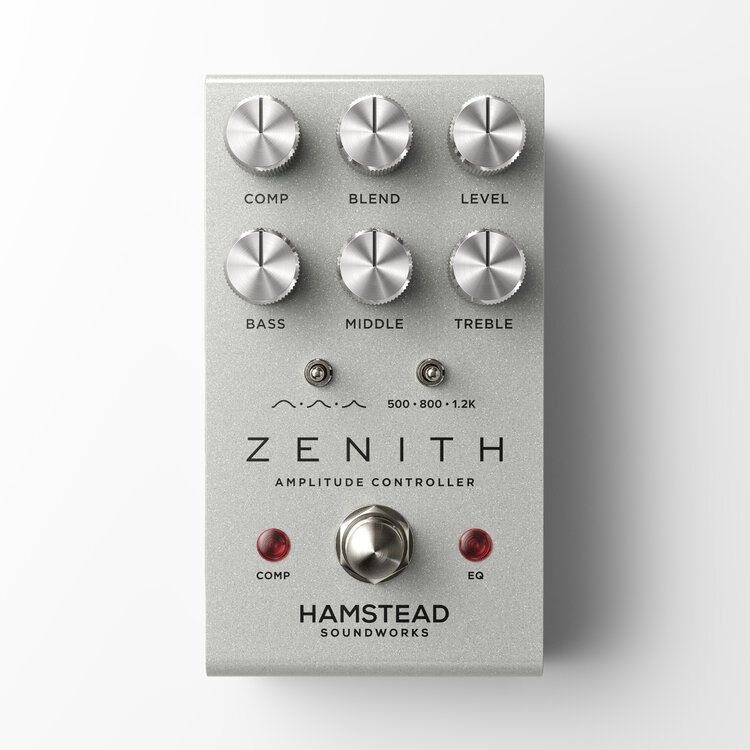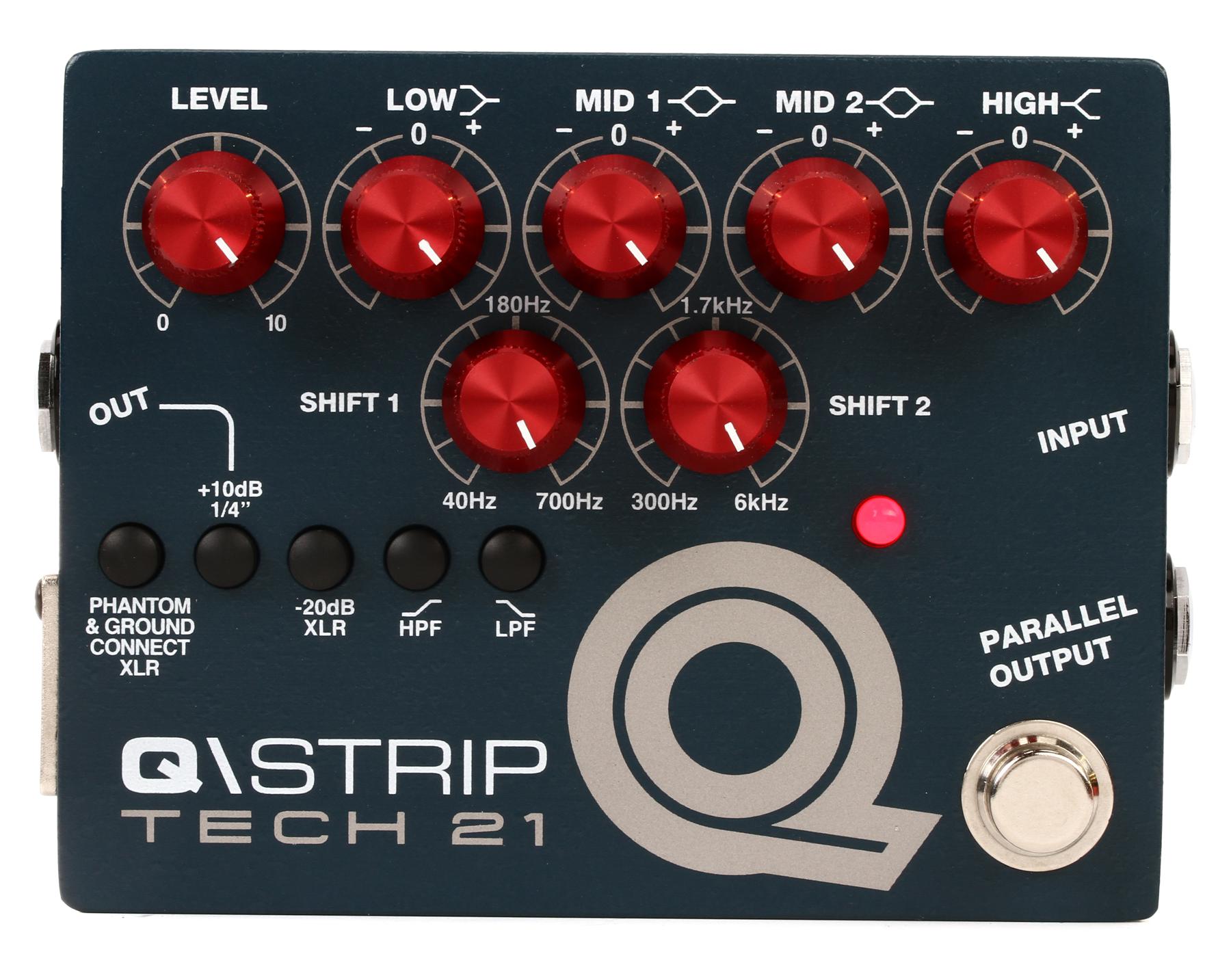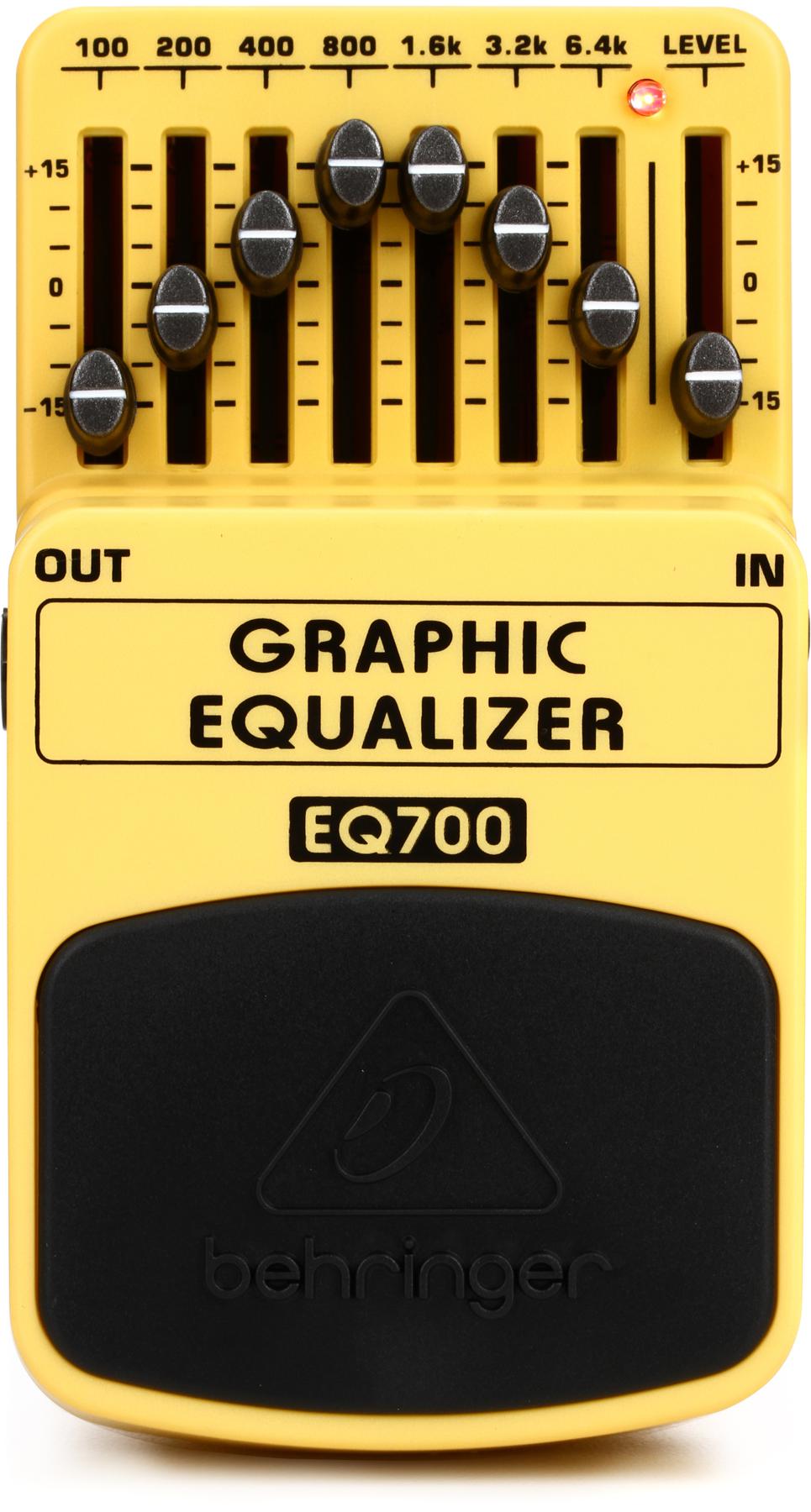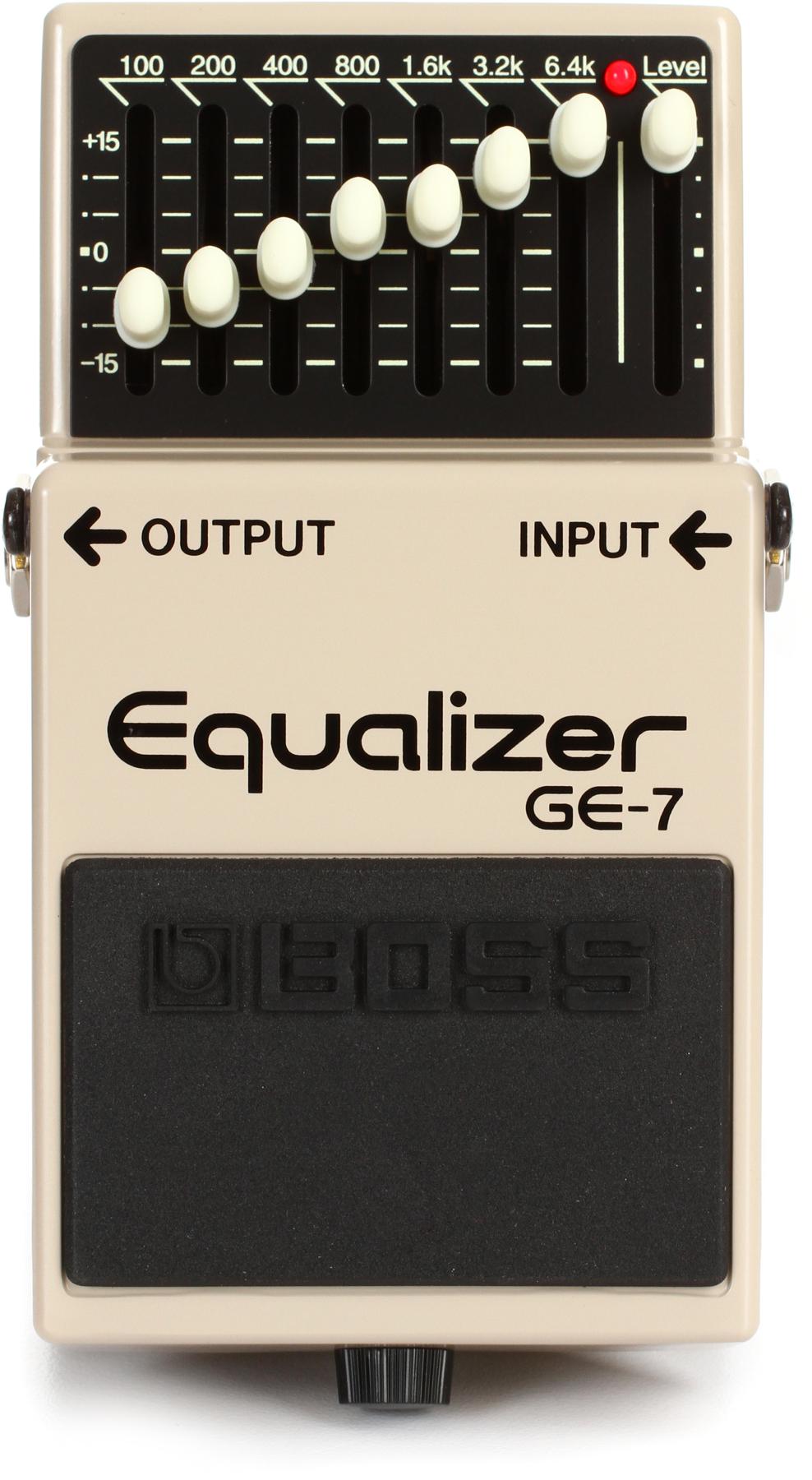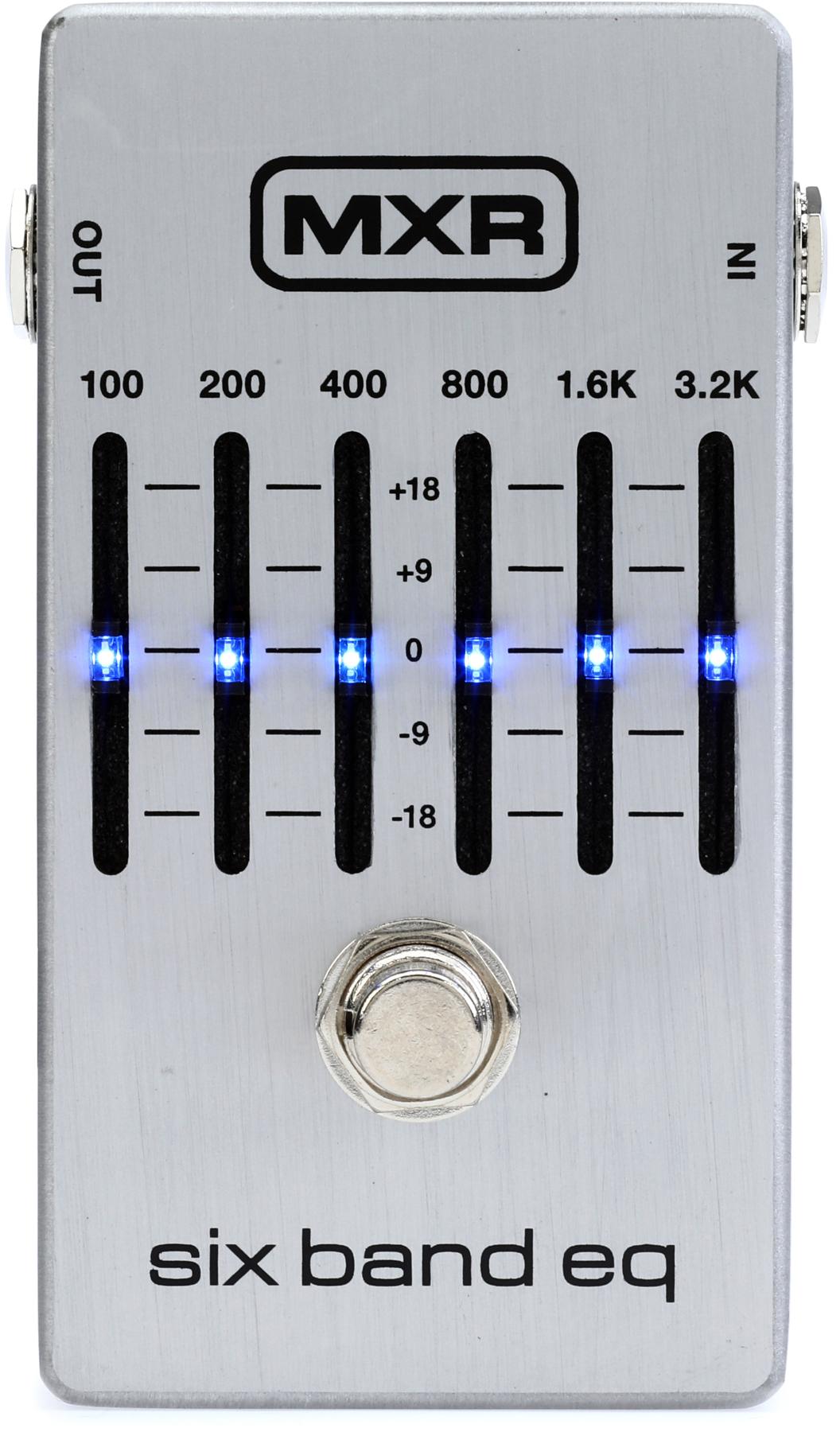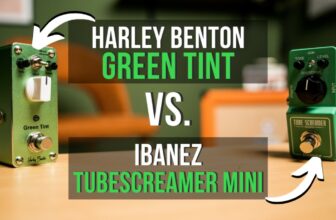The 7 Best EQ Pedals for Guitar and Bass (2024)
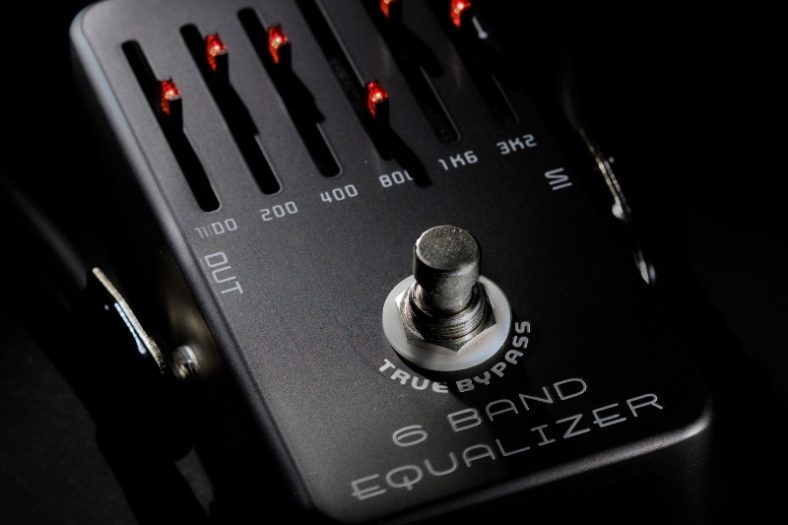
EQ pedals are one of the most necessary tools for a successful mix and mastering, whether with a guitar, a bass guitar, or any other instrument. It allows you to cut or boost specific frequencies to fine-tune, shape, and define your overall sound.
Having an EQ pedal on your pedal setup is crucial for guitarists and bassists to have more control and influence over the final sound output.
My top pick for guitarists looking for an EQ pedal is MXR M108S Ten Band EQ which gives you a wide range of control over ten bands of frequencies to shape your sound in detail.
If you want to go for my budget pick, you can check Behringer EQ700, a great 7-band EQ with a good value-for-price ratio.
Contents
- The 7 Best EQ Pedals for Guitar and Bass (2024)
- 1. MXR M108S Ten Band EQ
- 2. Behringer EQ700
- 3. Boss GE-7
- 4. Boss EQ-200
- 5. Hamstead Soundworks Zenith
- 6. MXR M109S Six Band EQ
- 7. Tech 21 QStrip
- What is an EQ pedal?
- What types of EQ pedals are there?
- What to look out for when buying an EQ pedal?
- Can an EQ pedal be used for both a guitar and a bass guitar?
- Is an EQ pedal essential for pedal setups?
- Summary
The 7 Best EQ Pedals for Guitar and Bass (2024)
Let’s compare them in more detail:
1. MXR M108S Ten Band EQ
My top EQ pedal pick is MXR M108S Ten Band EQ, a versatile graphic EQ with great noise reduction circuitry, a true bypass switch, a lightweight aluminum case, ten EQ bands, and volume gain adjustment slides.
Pros
- Ten-band EQ with up to 12dB boost
- Great extra features
- Natural sound and great noise-reduction circuitry
- Dual outputs for 2 different signal chains
Cons
- LEDs may be a bit too strong for some
The ten bands start from 32.25 Hz, going up to 16 kHz, which you can boost or cut up to 12 dB. This gives the users high control over their sound. Plus, MXR M108S has dual outputs, allowing it to be used for 2 different signal chains.
There is not much to say against the MXR M108S. Some users have reported that bright LED lights can disturb the eyes, but others like them as they make it easier to manage the pedal in the dark.
| Frequencies | 32.25 Hz, 62.5 Hz, 125 Hz, 250 Hz, 500 Hz, 1 kHz, 2 kHz, 4 kHz, 8 kHz, 16 kHz |
| Controls – Switches | 10 band sliders, 1 master level, 1 gain – True Bypass |
| Input | 1 x 1/4″ |
| Output | 2 x 1/4″ |
| Type | Graphic |
| Ease Of Use | Easy |
MXR M108S is a great ten-band-EQ with great extra features, making it a good choice for guitarists and bassists to take control and shape their sound as they desire.
2. Behringer EQ700
Behringer EQ700 is a great beginner EQ pedal which is a more affordable clone of the iconic Boss GE-7 EQ pedal. EQ700 features 7 frequency adjustment sliders ranging between 100 Hz and 6.4 kHz and up to 15 dB boost or cut. These allow the guitarists to have a wide range of control over their sound.
Pros
- Great value for the price
- Wide range of adjustment options
- Affordable
Cons
- Plastic, not the best build quality
EQ700 also has a volume adjustment slider and an LED that shows if the pedal is on or off and the status of the battery. This pedal is more suited for guitarists, as Behringer has the BEQ700 model, which is a Bass EQ pedal.
As this is a low-end EQ pedal, it does not have many bells and whistles. It is made from plastic, making the pedal-less durable. So, you have to treat it with care. Furthermore, some users report that the noise reduction is not the best as the pedal adds significant noise to the signal chain.
| Frequencies | 100 Hz, 200 Hz, 400 Hz, 800 Hz, 1.6 kHz, 3.2 kHz, 6.4 kHz |
| Controls – Switches | 7 band sliders, 1 master level – On/Off |
| Input | 1 x 1/4″ |
| Output | 1 x 1/4″ |
| Type | Graphic |
| Ease Of Use | Easy |
Overall, the Behringer EQ700 is a great pedal when its price is considered. If you are a beginner guitarist looking for a simple EQ pedal, this one can get the job done.
3. Boss GE-7
When talking about guitar pedals, it is hard not to mention Boss products. Not surprisingly, Boss GE-7 is one of the most-used equalizer pedals, thanks to its simplistic yet high-quality design with a 7-band equalizer allowing from -15 dB to +15 dB adjustment and a good noise reduction circuit.
Pros
- Wide range of adjustment options
- Solid build quality
- Good noise reduction
- Easy to use
Cons
- Does not have many features
Boss GE-7 features a nice and sturdy aluminum stompbox with the traditional Boss design and is a pretty straightforward EQ pedal to use. It does not have many features, but it gets the job done successfully. It lets you adjust the frequencies between 100 Hz to 6.4 kHz.
This is a pedal that’s oriented for guitars, and Boss has the GEB-7 model, the Bass Equalizer version of this same model.
| Frequencies | 100 Hz, 200 Hz, 400 Hz, 800 Hz, 1.6 kHz, 3.2 kHz, 6.4 kHz |
| Controls – Switches | 7 band sliders, 1 master level, On/Off |
| Input | 1 x 1/4″ |
| Output | 1 x 1/4″ |
| Type | Graphic |
| Ease Of Use | Easy |
There are many clones of Boss GE-7 as it is an industry-standard pedal like many of the other Boss products. If you want a simple yet high-quality EQ pedal on your setup, you can not go wrong with Boss GE-7.
4. Boss EQ-200
Boss EQ-200 is one of the most versatile EQ pedals out there. It has 10-band frequency adjustment sliders, built-in 128 presets, an EQ recall feature, and the option to use it for 2 different mono signals or a single stereo signal, along with its graphic display, making everything easier.
Pros
- 2 highly adjustable 10-band EQs in one
- Feature-packed
- Eq recall feature
- External switches, an expression pedal, and MIDI connectivity
Cons
- A bit pricey
The 10-band switch can be used for 2 different signals or right and left signals for stereo separately. There is the option to boost or cut the frequencies up to 15dB, and there are 3 ranges to choose from for the frequency range: 28 Hz to 14 kHz, 30 Hz to 12.8 kHz, and 32 Hz to 16 kHz.
The EQ-200 comes with many connectivity options such as MIDI in and outs, jack input for external switches or expression pedals, and a micro-USB port to connect it to a computer for system updates. To get the most out of this pedal, it is better to use it with a controller and MIDI.
| Frequencies | 30 Hz, 60 Hz, 120 Hz, 200 Hz, 400 Hz, 800Hz, 1.6 kHz, 3.2kHz, 6.4 kHz, 12.8kHz |
| Controls – Switches | 10 band sliders, 1 master level, Channel, Memory – On/Off, Memory Switch |
| Input | 2 x 1/4″ |
| Output | 2 x 1/4″ |
| Type | Graphic |
| Ease Of Use | Medium |
Although it is not an affordable pedal, Boss EQ-200 is a great choice for guitarists and bassists who want a feature-packed advanced EQ pedal for total control.
5. Hamstead Soundworks Zenith
Hamstead Soundworks Zenith is more than just an EQ pedal as it is a so-called “amp extender” with a 3-band EQ, compression, and boost features in one stompbox. The boost feature allows you to gain up your tone up to 20 dB, while the compression mode is quite simply fixed with a fast attack and medium decay while you can control the compression level and the blend of dry-wet sounds.
Pros
- EQ, compression, and boost in one pedal
- Transparent EQ with extra mid options
- Solid build quality
Cons
- Pricey
The semi-parametric EQ of Hamstead Soundworks Zenith sounds natural and great with Bass, Mid, and Tre adjustment knobs, and Mid Q and Frequency switches for more Mid control. The switch allows you to change the mid frequencies between 500 Hz, 800 Hz, and 1.2 kHz.
While the EQ and compression of Hamstead Soundworks Zenith are not as detailed as dedicated pedals, they provide enough performance and versatility for most guitarists and bassists while sounding natural and smooth.
| Frequencies | Bass, Mid, Tre |
| Controls – Switch | Comp, Blend, Level, Bass, Middle, Treble, Q, Freq – Mid Q, Mid Frequency, True Bypass |
| Input | 1 x 1/4″ |
| Output | 1 x 1/4″ |
| Type | Semi-Parametric |
| Ease Of Use | Medium |
If you want to hit more birds with one stone and have a high-performing multi-functional pedal in your setup, and you have the high budget to spend some more bucks on a pedal, Hamstead Soundworks Zenith can be a good choice. It can work as a full-featured preamp with compression, EQ, and boost functions in one stompbox.
6. MXR M109S Six Band EQ
MXR M109S Six Band EQ is the little brother of my top pick MXR M108S Ten Band EQ. It lacks four frequency bands, has fewer features, and has a more affordable price tag than its bigger brother. However, the sound quality and the great noise reduction circuitry make this pedal stand out for guitarists who want a simple yet good-quality EQ pedal.
Pros
- Great value for the price
- Natural sound and great noise-reduction circuitry
- Wide range of adjustment options up to 18 dB boost
Cons
- No master volume or gain adjustments
- Not very suitable for basses
With its smooth and natural sound, MXR M109S Six Band EQ is a great value for the offered price and up to 18 dB boost range; it allows even more boost than its bigger brother. However, the lack of master level and gain volume knobs might be a problem for some guitarists.
Also, I recommend the bass players go for the bigger brother as the MXR M109S Six Band EQ does not feature as many lower-end frequency adjustments as the MXR M108S Ten Band EQ. But for guitarists who are not too detail-oriented and have other pedals to compensate for the lack of features on this one, there is not much difference between both pedals.
| Frequencies | 100 Hz, 200 Hz, 400 Hz, 800 Hz, 1.6 kHz, 3.2 kHz |
| Controls – Switches | 6 band sliders – True Bypass |
| Input | 1 x 1/4″ |
| Output | 1 x 1/4″ |
| Type | Graphic |
| Ease Of Use | Easy |
MXR M109S Six Band EQ is a good EQ pedal for guitarists who are after a high-quality, natural-sounding, and simple EQ pedal.
7. Tech 21 QStrip
The Tech 21 QStrip is an advanced preamp pedal with 4 bands of EQ with the two mid bands allowing for parametric control, low and high-pass filters, three modes of operation, smooth-action actuator switch, speaker simulator function, and its warm and large tone just like the vintage devices.
Pros
- Extremely feature-packed
- EQ, DI, volume boost, speaker emulator in one stompbox
- Robust build quality
Cons
- Pricey
- A bit complex for beginners
With its feature-packed design, Tech 21 QStrip gives total control over the shape of your sound. If you have music knowledge, you can create great tones with this pedal. It can be used with guitars as well as basses as it offers control on a wide range of frequencies and up to 18 dB of cut and boost.
This is not suitable for beginners as more control brings more responsibility and requires more knowledge.
| Frequencies | Low, Mid 1 (40 Hz- 700Hz), Mid 2 (300 Hz 6kHz) , High |
| Controls – Switches | volume, low, mid 1, mid 2, high, shift 1, shift 2 |
| Input | 1 x 1/4″ |
| Output | 1 x 1/4″ or XLR with phantom power |
| Type | Semi-Parametric |
| Ease Of Use | Hard |
To summarize, Tech 21 QStrip offers a great range of features with a warm and natural vintage-style sound for guitarists and bassists who want complete control over their sound. It is a high-end product, but you get what you pay for.
What is an EQ pedal?
To put it simply, an EQ or an equalizer pedal is a tool to cut or boost particular frequency ranges of your sound. This way, EQ pedals allow you to balance your instrument’s sound in the mix and in itself by adjusting the relative amplitudes of the frequencies within the signal.
There are many different EQ pedals, from elementary ones that focus on only one frequency range, such as mids, to more advanced ones that allow you to shape 10 frequency bands. Usually, there are 3-band, 5-band, 6-band, 7-band, and 10-band equalizer pedals.
There are 3 important factors in equalization: frequencies, Q (quality factor), and gain. Frequencies, measured in Hertz, are different tonal ranges of the audio spectrum. Q is the quality factor that indicates the cut or boost, narrow-steep, or wide-gentle. And, finally, the gain is the power of the cut or boost.
What types of EQ pedals are there?
There are 3 types of EQ pedals: Graphic EQ, Parametric EQ, and Semi-Parametric EQ.
As the name suggests, Graphic EQ pedals are designed in graphic-shaped interfaces and are the most popular EQ pedals. They typically feature different numbers of frequency bands controlled by the amplitude sliders on the pedal to boost or cut specific frequencies.
They are effortless to control as users can visualize the EQ curve by looking at the pedal. These pedals may or may not feature gain and master volume controls, but they do not have Q control.
Parametric EQ is the most advanced EQ pedal type, as it gives you total control of equalization. They feature an interface with knobs that are used to boost or cut the frequency bands and the Q value of the frequencies.
Parametric EQ pedals also allow the users to sweep for center frequencies to cut or boost. They generally have gain and master-level knobs as well as extra features.
Semi-parametric EQ has the features of a parametric EQ, partly. Usually, they have fixed bass and treble frequency knobs but a sweepable Mid adjustment knob with Q control. Also, another common type of Semi-Parametric EQ has all of the features of Parametric EQ pedals without the Q control.
What to look out for when buying an EQ pedal?
When buying an EQ pedal, there are many things to consider, including EQ type, number of frequency bands, extra features, and price.
You should first consider which type of EQ you want and need. Graphic EQ pedals are the most common and the easiest to control, and they are suitable for beginners and musicians who want simplicity. Parametric and Semi-Parametric EQ pedals give you more control over your sound, but you will need musical knowledge and background to handle them.
Next, you have to figure out how many bands you want to have on your EQ pedal. Guitar EQ pedals typically have 6 to 10 bands and are usually graphic type. More bands mean more control over your tone.
You should also check what other features the EQ pedal you are looking for have. Having a master level and gain adjustment knob or slider would give you more control over your tone. Furthermore, connectivity options are also important for the versatility of the pedal.
Finally, the most crucial aspect for many is the price. You have to calculate your budget well and leave room for other gear, as spending all of your budget on an EQ pedal is not wise. Look for cost efficiency rather than extra features if you have a tight budget.
Can an EQ pedal be used for both a guitar and a bass guitar?
Yes, many pedals give you control over a wide range of low-end frequencies and mid-frequencies, which are crucial for bass guitars and guitars, respectively. Boss EQ-200, Tech 21 QStrip, Hamstead Soundworks Zenith, and MXR M108S are great examples of these types of EQ pedals.
Is an EQ pedal essential for pedal setups?
Yes, for a professional tone, EQ pedals are crucial for guitarists and bassists. Although there are EQ controls on some other pedals and amplifiers, dedicated EQ pedals provide much more versatility and control over your sound.
The EQ pedals allow you to cut the unwanted frequencies or boost the lacking ones. You can also use them as booster pedals when you want to stand out in the mix, for example in solos. Also, you can use EQ pedals for tone adjustments and shaping by locating them in different places in the signal chain. For example, putting an EQ after the amplifier and lowering the highs and lows can give you a radio effect.
You can also shape your sound better with a dedicated EQ pedal, as 3-band EQ knobs on amps are not enough. The EQ system on most amps is passive, which means they can only cut the frequencies, but they can not boost any. You can boost your tone only with a dedicated EQ pedal when your tone lacks frequency.
Summary
EQ pedals are pretty versatile and crucial elements of every pedalboard. Having the ability to shape your tone, cutting, or boosting specific frequencies is vital to having a professional-sounding tone and avoiding disturbing noises.
My top pick is MXR M108S Ten Band EQ which gives guitarists and bassists control over 10 bands of frequencies along with extra features and high sound quality.
If you do not want to spend much on an EQ pedal, you can go for my budget pick, Behringer EQ700, with its simple layout and control over 6 bands of frequencies.

